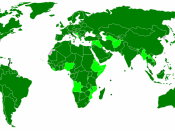This assignment is about the crisis that affected Argentina in 2001. First of all, we will try to understand how this crisis occured. In a second part, we will see the measures taken by the Argentinian government and will analyse of the results of those measures. Then, we will take a look at the interventions of the International Monetary Fund and their consequences. To conclude, we will analyse this crisis, trying to determine what could have been done and what to learn from this economic disaster.
After its crisis at the end of the 1980's, Argentina started to find the road to a good health on April 1rst, 1991, when Carlos Menem's government installed the "convertibility system" to fight against hyperinflation. Under the Convertibility law, the peso and the U.S. dollar circulated at a "1 to 1 exchange rate". The owner of a peso had a property right for a dollar and could freely convert this peso into a dollar.
The crisis of 2001 originated in a complex mix of problems that had been at work from the mid-1990s or even before. The crisis also was the result of a weak financial systems that became too exposed to exchange rate risks as well as the large-scale capital inflows driven by cyclical downturns in the industrialized countries in the early 1990's. To this can be added an excessive demand which rose asset prices fueled by strong credit expansions, speculative and imprudent investment decisions, weak or clumsy governance of companies and banks and a general lack of transparency in the public sector.
In concrete terms, Argentina's economy went into recession in September 1998 as a consequence of the Asian and Russian currency crises, which finished in a general decline in volumes of investment to emerging market economies. The Brazilian currency crisis of...

![International Monetary Fund [oct 25]](https://s.writework.com/uploads/3/37331/international-monetary-fund-oct-25-thumb.jpg)
